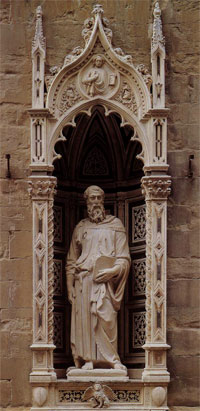St. Mark
St. Mark was the first of the three statues executed by Donatello for Orsanmichele, the Church of the Merchants. A former open Loggia and corn market, Orsanmichele became one of the most elaborate examples of architecture.
Built in 1280 by Arnolfo, it was later destroyed by fire, and then rebuilt in 1337 according to the original plans. In 1355 the open arches were filled under the direction of Orcagna, and at the same time the scheme of exquisite decoration was planned.
Each Guild was required to contribute to the beautifying of the building, and to place on its exterior a statue of its patron Saint. Only the major Guilds were entitled to have statues of bronze. A place on the wall was assigned to each Tabernacle, and over it a medallion bearing the Guild stemma. There are fourteen of these Tabernacles on the walls, the earliest being built in the 14th century.

Donatello - St. Mark
St. Mark history
Donatello’s St. Mark was commissioned in 1411 by the Arte dei Linaioli (the Guild of linen manufacturers), members of the Arti Mediani category. As a result, the statue is of marble, as they were not entitled to have a bronze statue, reserved only for the Arti Maggiori.
The Guild wanted the sculpture to be finished within eighteen months, and did not assume any responsibility regarding the installation: the heavy statue was to be placed in the niche at the sculptor’s own risk.
The Tabernacle was executed in the same time as the statue, but is not the work of Donatello. It was commissioned in 1411 to the sculptors Perfetto di Giovanni and Albizo di Piero.
Vasari is saying that Brunelleschi co-operated on the St. Mark. However, there is no official document to confirm his assertion.
St. Mark analysis
St. Mark is one of the noblest of Donatello's sculptures, and intellectual energy has perhaps never been so magnificently interpreted in art.
Apparently, the Guild gave Donatello the height of the statue, leaving him to select the corresponding proportions. According to Vasari, when the commissioners saw the sculpture in Donatello’s workshop, the artist ran the risk of his work being refused, as they claimed that St. Mark looks unnatural and does not comply with their requirements.
The problems were due literally to a lack of perspective. Donatello knew that the sculpture will be installed at about 8 feet above the street level, and the sculptor took great care in adapting the statue exclusively to the future lighting conditions and position. Definitely the work was not supposed to be analyzed from close proximity on the ground.
The artist knew exactly what caused the unfavorable impression, and he obtained the permission to set the sculpture in its niche, in order to correct his faults. He completely concealed the statue, and for two weeks pretended to work at it. Actually he did not touch it, and when he uncovered it, those who before wanted to reject the sculpture were amazed by its beauty.
St. Mark is showing conviction, and great skill. The pose is majestic and intellectual, having the appearance of a scientist and thinker, an impression accentuated by the heavily developed brow. The face is grave yet kindly, devout and holy, together with a certain simplicity of attitude, giving St. Mark the character of a simple and lovable person who would make all to trust him. His eyes seem to flash. The pose of the entire statue is in accordance with the face, profoundly intellectual, and conveying the sense of majesty.
As the great Michelangelo noticed, the young sculptor successfully brought life into his statue. The hair has the appearance of living growth, the beard is parted in massive curls, and is treated with the knowledge of its natural look. The face has character, the pose is firm yet easy. In Michelangelo’s words, it is impossible “to reject the Gospel from so straightforward a man as this.”
The sole defects of the sculpture may be the legs, somehow shorter than one would expect in relation to the body. As it was the case with Donatello’s early works, the hands are large and roughly modeled.
St. Mark’s statue is a perfect example of the Donatello’s exquisite treatment of drapery, which under his hands comes alive. The folds are not mere decorative arrangements of lines, they are not a simple cover for the figure. Going beyond the exclusive consideration of line, Donatello studied the section of the folds. St. Mark and all his later works will show his drapery effect, the living air within the folds. St. Mark is proof of Donatello’s successful efforts to infuse life and reality into the traditional treatment of the statue.
St. Mark is maybe one of the most expressive sculpture creations in existence. It embodies the moral and intellectual energy of Renaissance Florence.
Donatello: Life and sculptures
The marble and bronze David statues